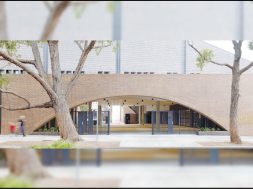The design story of Darlington Public School

Our design reflects our commitment to creating a learning environment that seamlessly integrates with the community, celebrates indigenous culture, and fosters holistic education for future generations.
A primary school represents the foundation of a child’s first formal learning experience. The design concepts for Darlington needed to embody the school’s core values. The school is a community school with strong connections to Aboriginal people. The design connects the school to its surroundings, offering glimpses of the inner courtyard from the main entrance, promoting a sense of privacy and community for the children designed by fjc studio.
The screen that protects the outdoor learning terraces is safe and secure and provides a beautiful dappled light reminiscent of the light passing through the casuarina leaves – endemic to the area of Blackwattle Creek. Darlington Public School is a true community school, and the publicly accessible functions – the community hall, the COLA, and the library- need to be located to become an integrated part of the surrounding urban landscape. The scale of the new hall responds to the scale of the adjacent church, and the library sitting within the landscape provides a softer, more organic connection to the community.
The school sits between the University of Sydney’s large scale and the Darlington terraces’ finer grain. The previous school, which had reached the end of its life, had been a demonstration school; therefore, the spirit of this school needed to be maintained for the community. Collaboration with educational consultants, New Learning Environments (NLE), and the school community led to a functional brief providing an inclusive learning environment. Learning hubs, accommodating 2 or 3 student groups, are distributed across two upper levels and feature diverse spaces, including wet areas, presentation spaces, quiet rooms, informal learning areas, teacher hubs, and connected outdoor learning terraces. The preschool, though connected, maintains a separate space for a safe learning environment.
The design process prioritised a collaborative approach, crucial for integrating the built form and landscape, resolving major cross-falls on the site, and creating a true connection to the landscape. The master plan divided the construction into two stages, allowing continuous school operation and eliminating relocation costs. Material selection focused on cost-effectiveness, durability, and minimised operational expenses. The design emphasises a connection to landscape and country, embracing sustainability with passive design elements such as saw tooth roofs angled to the sun, high-level glazing for indirect daylight, and protective curved screens for filtered daylight. The design embraces the rich indigenous culture and the artistic heritage of the school – so important to the community.
The extensive collection of Aboriginal artworks has been preserved and displayed around the school. QR codes have been provided to enable a continued curation of the works as stories are uncovered. Murals painted on demolished walls were photographed and reproduced in the cladding, offering a tactile response and adding a new layer of interpretation, preserving stories of the country for future generations. The landscape further contributes to learning opportunities with QR codes describing the names and uses of indigenous plants, reinforcing the school’s commitment to a holistic educational experience.
For more details: https://fjcstudio.com/
Cookie Consent
We use cookies to personalize your experience. By continuing to visit this website you agree to our Terms & Conditions, Privacy Policy and Cookie Policy.










